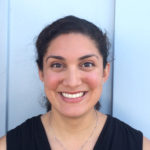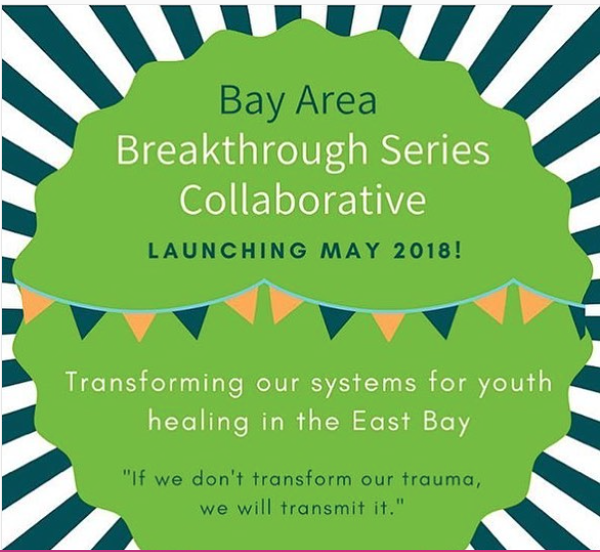Oakland BSC activity: Photo/ Courtesy of Trauma Transformed/East Bay Agency for Children
When a group of community organizations in Baltimore came together in 2015, they already knew trauma figured large in many lives. There was violence in the community, in schools, and in community members’ homes. Police brutality occurred. Many suffered the loss of loved ones to incarceration or death. There were house fires and homelessness. Much of the dysfunction was systemic and rooted in racism, according to a report on a collaborative effort to restructure city organizations and agencies. The goal was to build community resilience.
Baltimore BSC faculty and planning team
In 17 months of development — trying out, modifying and putting plans into action — the Baltimore Breakthrough Series Collaborative (BSC) brought together nine different teams, trained and educated 928 people about trauma and resilience, screened 638 people for trauma, referred 321 people for mental health care, expanded connections into 50 new collaborations, created 27 “trauma-free” zones, relied on a “it’s not for us if it’s not by us” concept of families and community members defining what needed to change and how, and each developed their own way to measure growing resilience. And now the model is being put into place in Oakland, California.
The nine Baltimore-based teams were: Advanced Therapeutic Connections; Bon Secours Behavioral Health; Communities United; ED Pride Program at Baltimore City Schools;The Family Tree; House of Ruth, Maryland; KidzStuff Childcare Center/Sage Wellness Group; New Lens; and Pressley Ridge. The teams are a mix of grassroots community and youth social justice organizations; organizations that provide mental health, child abuse prevention, and child care services; as well as agencies that serve foster youth and families who have experienced domestic violence.

For the Oakland participants, the BSC model was a good fit, says Francesca Osuna, the trauma-informed implementation and evaluation coordinator for the East Bay Agency for Children. “We thought it was a good opportunity to bring together agencies that don't usually work directly together and have them share and learn with each other,” says Osuna, who is coordinating the program planning in the Oakland BSC. “It’s a good opportunity for them to share their wisdom.”
How did it work in Baltimore? Rochell Barksdale can see the fruits of that training first hand. The mother of two, who lives in Baltimore, took what she learned from the collaborative, and started a trauma-support group in 2016 in the public housing complex where she lives. And it’s been growing ever since.
“It started in my home, and when my home got too small, we moved to a church,” says Barksdale, who is a member of the grassroots group Communities United, one of the BSC teams. The trauma-support group, which meets monthly, now gathers at a center at her son’s elementary school. As many as 16 people attend the meetings.
“I cook food and we talk about different types of trauma,” explains Barksdale, who says that she joined Communities United because it fit in with her values of being raised in the Black Panther era and taught to fight for what she believes in.
And it’s within that relaxed environment with the smell of food warming up the room that Barksdale says people open up. “We’ve had several people whose sons had been murdered or shot in the neighborhood. And we talk about how they felt and what they’re going through.”
It’s an atmosphere, she says, where they offer each other prayers and resources that many did not know were available, as well as small nudges to push people beyond discomfort to seek help. ‘A lot of people won’t go to a psychologist or psychiatrist because they think they don’t need the help, but also because they think people will think they’re crazy,” she explains.
Barksdale used her own experience to help others see mental health care differently. “When I was 30, my nephew, who was deaf, did not have the aide there to get him off the school bus,” she explains. He got off anyway and the bus ran him over, killing him. Barksdale, who was very close to her nephew, was devastated, became depressed, anxious and began having panic attacks. “I went to my medical doctor because I had palpitations in my heart. I couldn’t breathe. I feared things I never feared before, and I thought I was dying,” she recalls. She recounted this to support group members and explained how trauma can affect the body and told them that it was mental health therapy that got her through it.
“They were like ‘Oh my God, I’ve been there, but I didn’t know what to do!’” she says.
The support group that Barksdale founded also hosts speakers who talk about trauma from different perspectives and offer ways to take action. Experts have talked with them about abuse in relationships, special-needs children and bullying at school. The discussion about bullying led a group of them to show up at a school principal’s office and demand an end to it, according to Barksdale. After several meetings between parents, students and the principal, Barksdale said, it was resolved. The bullying actually stopped.
Although Barksdale and others in the Baltimore BSC all received trauma and resilience training, it was offered with the goal that they decide how to best share it with their own organizations and community members. In fact, each of the nine teams are invited to select their own method of learning and adapting trauma training to their specific needs, says Kay Connors, a member of the planning team for the BSC in Baltimore and Oakland, and the project director of the Family Informed Treatment Center at the University of Maryland School of Medicine, Department of Psychiatry. For example, “One of the Baltimore BSC teams bought a brain architecture game to teach their board about ACEs and trauma,” said Connors.
That kind of flexibility of the BSC model was one of the many draws for the East Oakland Youth Development Center (EOYDC) to be part of the Oakland BSC, says the group’s Vice President of Organizational Effectiveness Selena Wilson. “I think one of the stickiest things for us has been finding the right set of [trauma training] tools that will work with the population we work with — adolescents. Most of the tools and handouts are for smaller children or for adults,” says Wilson. And, she says, the material doesn’t really speak to the population her organization serves.
“It’s not really representative of us. [The documentary] ‘Paper Tigers’ is great, but those kids don’t look like our kids, so it’s not going to resonate very much,” she explains. “Frankly, we’ve had to make up our own stuff and ultimately we want to share what we’re doing.”
Another flexible element of the BSC model is that each team develops their own way to measure resilience. In Baltimore, according to the BSC report, one of the teams used ProQOL, a tool that measures vicarious trauma, and burnout as well as resilience among workers who provide services to clients who have experienced trauma. In Oakland, some of the plans for increasing resilience involve developing advisory groups that includes community voices, according to Laurel Kiser, who is on the planning team for Baltimore and Oakland, is assisting with evaluating organizational changes, and is an associate professor In the Department of Psychiatry at the University of Maryland School of Medicine. One question to measure resilience could be, for example, “Do those new roles that youth and community members are taking on create in them a sense of empowerment and ability to have their voice and feel effective?” Kiser says.
 In Oakland, the BSC teams are: Youth ALIVE!,which trains youth how to steer clear of violence; Youth UpRising, which uses health, wellness, educational, career, arts and cultural programming to disrupt the cycle of poverty and violence; Youth Homes, a group devoted to helping traumatized and foster youth; the East Bay Agency for Children, which offers safety-net services and training to families and children as well as trauma-informed training to workforces through its program Trauma Transformed; and the UCSF Benioff Children’s Hospital.
In Oakland, the BSC teams are: Youth ALIVE!,which trains youth how to steer clear of violence; Youth UpRising, which uses health, wellness, educational, career, arts and cultural programming to disrupt the cycle of poverty and violence; Youth Homes, a group devoted to helping traumatized and foster youth; the East Bay Agency for Children, which offers safety-net services and training to families and children as well as trauma-informed training to workforces through its program Trauma Transformed; and the UCSF Benioff Children’s Hospital.
To move forward, the Oakland teams are now looking inward at their strengths, where they would like to grow, and how they want to measure that growth, according to Osuna, who says they’ll all meet together again in October. At past meetings, says Osuna, “There was a general feeling of optimism in the agencies coming together to create more community.”



Comments (0)